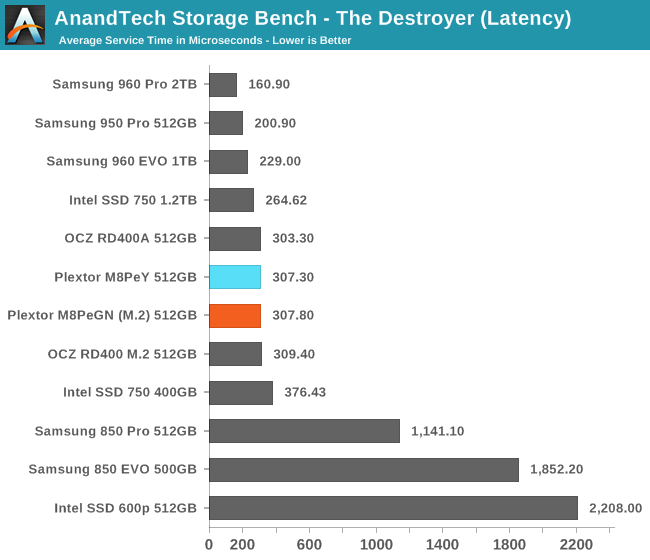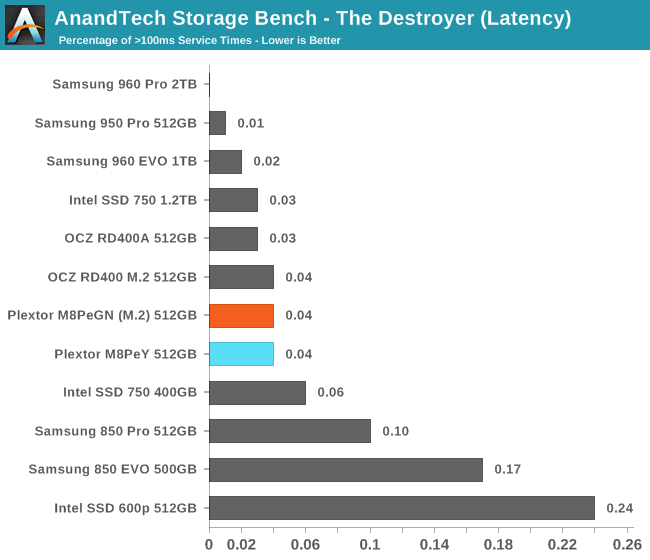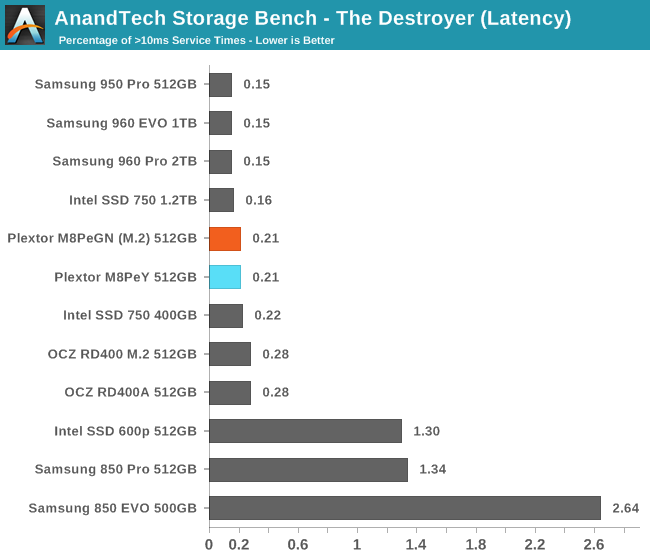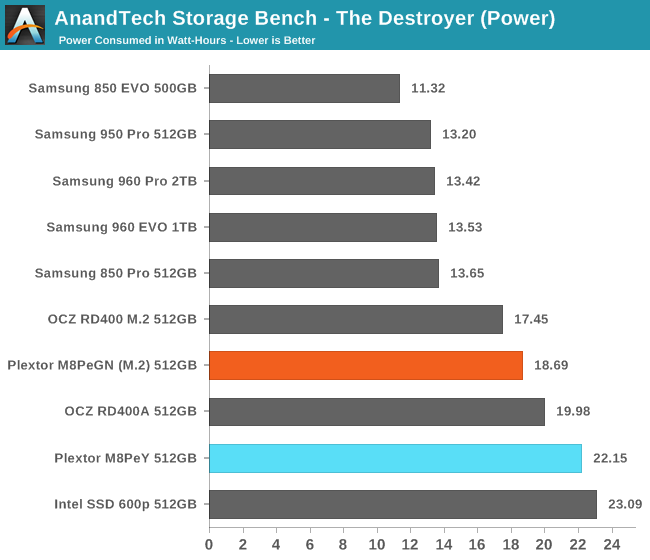The Plextor M8Pe (512GB) SSD Review
by Billy Tallis on December 14, 2016 9:00 AM ESTAnandTech Storage Bench - The Destroyer
The Destroyer is an extremely long test replicating the access patterns of very IO-intensive desktop usage. A detailed breakdown can be found in this article. Like real-world usage and unlike our Iometer tests, the drives do get the occasional break that allows for some background garbage collection and flushing caches, but those idle times are limited to 25ms so that it doesn't take all week to run the test.
We quantify performance on this test by reporting the drive's average data throughput, a few data points about its latency, and the total energy used by the drive over the course of the test.

The Plextor M8Pe isn't breaking any records on The Destroyer. Its average data rate is slower than Samsung's PCIe SSDs and the OCZ RD400, but it does beat the Intel SSD 750 and is about 75% faster overall than the fastest SATA SSDs. The heatsink on the M8PeY only provides a very slight performance boost.

The average service times of the M8Pe are on par with the OCZ RD400 and the Intel SSD 750, and substantially worse than Samsung's PCIe SSDs. The differences are minor in comparison to the huge latency advantage they all enjoy over the best SATA SSDs (and Intel's TLC-based SSD 600p).


The frequency of high-latency outliers places the M8Pe in the second tier of drives. Samsung's PCIe SSDs have few or no operations take more than 100ms and the smallest percentage of operations that exceed 10ms. The M8Pe scores similarly to the Intel SSD 750 and OCZ RD400.

The Intel SSD 600p is the only thing keeping the M8Pe from taking last place for power consumption among M.2 PCIe SSDs. The M8Pe uses significantly more power than the OCZ RD400, which itself is more power-hungry than Samsung's SSDs.










64 Comments
View All Comments
MrSpadge - Wednesday, December 14, 2016 - link
Considering your ADATA is quite small at just 1 GB, these will be a noticeable upgrade. Starting from a 1 TB drive, though, will likely not be noticeable (unless you're running significantly I/O limited workloads).Ratman6161 - Wednesday, December 14, 2016 - link
Assuming you meant 1TB rather than 1 GB. Can the majority of humans tell the difference? I can't speak to what the majority can tell but I can state my personal experience. My main system drive is currently a 250 GB 850 EVO. I've also had an opportunity to (though briefly) to use a system with a 950 Pro in it. For anything that I personally do, no, I could not tell the difference. Of course I don't do anything particularly storage intensive either. I'm most concerned with boot up time and how fast programs open, etc.To me, given pricing as it exists today, there are only really three drives mentioned that I would even think about. Assuming you need an m.2 form factor (which I currently don't so will stick with my 850 EVO) 960 Pro if you want the best performance available, 960 EVO if you want great upscale performance at a reasonable price, and the Intel 600 P if you don't need great performance but do need the M.2 form factor. But if the prices change it may well be possible to just buy the cheapest in the particular performance class you want.
sinPiEqualsZero - Wednesday, December 14, 2016 - link
Thanks to both of you. I did mean 1 TB, my bad. I have one of the DAN cases and will be building it out in Jan/Feb, that's why I asked. Looks like I'm sticking with SATA unless prices come down. Mayyyyybe the 960 EVO.Bruce427 - Friday, December 16, 2016 - link
** [get] the Intel 600 P if you don't need great performance but do need the M.2 form factor. **Currently, the MyDigital BPX NVMe drives will significantly outperform the 600Ps, and for less money.
They also use MLC flash and have a full 5 year warranty.
I have several 950 Pros. I recently bought/installed a 240GB BPX for benchmarking/testing and at $107.85 (what I paid) it's a great little drive.
Death666Angel - Sunday, December 18, 2016 - link
MyDigital doesn't have European retailers it seems? At least nothing but one listing in Germany for a BP4. :/ddriver - Saturday, December 17, 2016 - link
No, 99% of the use cases won't show tangible improvement. SATA SSDs are already fast enough to eliminate storage as a bottleneck. You may have TB\sec and it will still not make a difference if the bottleneck is somewhere else.peterfares - Wednesday, December 14, 2016 - link
Why is there a power connector on top?Billy Tallis - Wednesday, December 14, 2016 - link
I think it's just an alternate power delivery path for situations where the PCIe slot doesn't provide enough. I didn't bother using it, since I was measuring power consumption through the PCIe slot.XabanakFanatik - Wednesday, December 14, 2016 - link
When are you going to redo new drives like the 960 Pro/Evo and RD400 with the angelbird wings PX1 so we can see how and if oerformance improves with a heatsink?Last year AT had redone benches from the 950 pro this way.
Billy Tallis - Wednesday, December 14, 2016 - link
At the moment, I'm more concerned with putting together an updated test suite for 2017. Once that's ready and everything's been re-tested, I'll go back and test the 960s with a heatsink. It'll probably be February, and probably won't be worth an article of its own.We already have the RD400A results in Bench, and the one thermal pad behind the controller that it uses was enough to eliminate thermal throttling (with one possible exception).